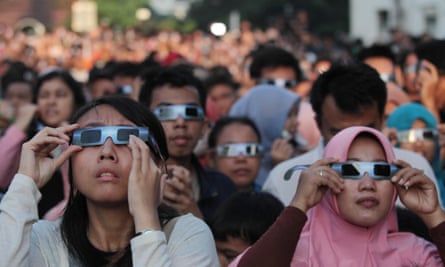The American solar eclipse is here. It will be visible across the United States during the morning and early afternoon of Monday 21 August.
If you’ve never seen a total eclipse of the sun, the chances are that you are going to turn to the internet for some tips on how to make the most of the opportunity. And you are going to find so much advice that – however well meaning – it is going to set your head spinning.
It’s a minefield of jargon such as first contact and umbra, and of things to look for like shadow bands and Bailey’s beads.
My advice is to forget it all and just enjoy the moment.
In trying to do everything you risk seeing nothing. It is no exaggeration to say that a total eclipse of the sun is one of the most extraordinary natural phenomena it is possible to see. So do yourself a favour and just soak it up.
To enjoy it, there are only three things you need to do.
No 1: get to the track of totality
Totality is the central moment of the eclipse. It is when the moon completely covers the sun.
The track of totality is the locations on the Earth where the total eclipse can be seen. Make no mistake, you have to be on the track of totality to see the total eclipse.
Nothing compares to totality. If you are a little way off and seeing a 95% partial eclipse, do not think that you will be experiencing 95% of a total eclipse. It simply does not work like that. Only if you are in the track of totality will the sky go dark and the beauty appear.
On 21 August, the track of totality is roughly 70-mile (113km) wide and moves from the west coast to the east coast. It starts near Salem, Oregon, and finishes near Charleston, South Carolina.
The eclipse begins in Salem at 9.05am PDT. The moon then takes over an hour to move across the sun and so totality starts at 10:18am PDT. In Charleston, the eclipse begins at 1.16pm EDT, with totality coming along at 2.46pm.
So get somewhere on the track. Once there, put out your deck chair, sit back and relax. You have made it, you are going to witness a total eclipse. And if the sky is clear, what you are going to see will make your jaw drop.
No 2: wear eclipse glasses
Never look at the sun with unprotected eyes. I cannot stress this enough. If you look directly at the sun with your naked eyes or through any kind of unshielded binoculars or telescope you could permanently damage your eyesight.
Eclipse glasses are widely available. They consist of a black polymer material mounted in cardboard glasses that hook over the ears. They should be worn whenever you look at the sun.

When totality begins, and you are plunged into darkness, then you can take your glasses off. At this point, the sun is no longer visible because the moon is blocking its light. As soon as the sun returns, put them on again.
Do not use sunglasses, smoked glass or a welder’s helmet. Eclipse glasses are cheap and much safer. Leave the welding helmet at home and as a bonus you’ll avoid looking like a child pretending to be a robot.
No 3: put the cameras down
Finally, leave the camera at home too, and put the mobile phone in your pocket. Totality will last for bare minutes and this will seem to pass in the merest blink of an eye.
As totality arrives you will see the pitch black silhouette of the moon where the sun used to be, and surrounding it will appear the faint tendril-like atmosphere of the sun, and a smattering of stars. If you haven’t seen an eclipse before, this is the moment that will change your life. The ephemeral beauty of the sun’s outer atmosphere, which is called the corona, is transcendental. The eerie cold that engulfs you as the sun’s rays are extinguished will literally and metaphorically chill you.
The first two items on my list are mandatory, this third one is optional but I believe it just as strongly. I’ve seen three eclipses, and when the time comes for me to see a fourth, I will go tech-free and just be in that marvellous moment – in the shadow of the moon.
Stuart Clark is the author of The Unknown Universe (Pegasus Books).

Comments (…)
Sign in or create your Guardian account to join the discussion